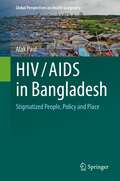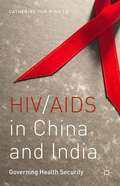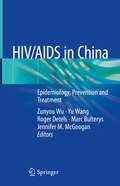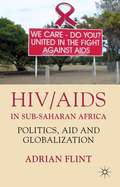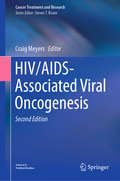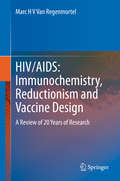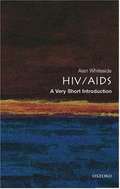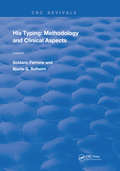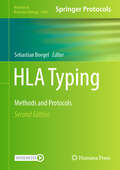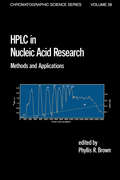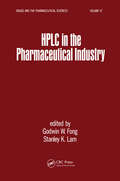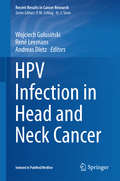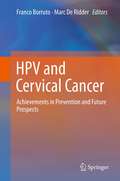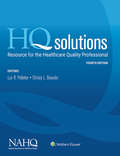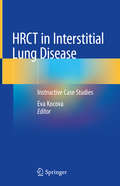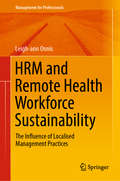- Table View
- List View
HIV/AIDS and the Drug Culture: Shattered Lives
by Joan Gormley Elizabeth HaganIn this startling new collection of case studies entitled HIV/AIDS and the Drug Culture: Shattered Lives, you‘ll take an eye-opening and informative look at the lifestyle and culture of the HIV/AIDS intravenous drug users (IVDUs). You‘ll see how health care providers and caregivers can update their methods and mindsets in order to meet the needs of
HIV/AIDS and the Social Consequences of Untamed Biomedicine: Anthropological Complicities (Routledge Studies in Anthropology #18)
by Graham FordhamDrawing on the case of HIV/AIDS in Thailand, this book examines how anthropological and other interpretative social science research has been utilized in modeling the AIDS epidemic, and in the design and implementation of interventions. It argues that much social science research has been complicit with the forces that generated the epidemic and with the social control agendas of the state, and that as such it has increased the weight of structural violence bearing upon the afflicted. The book also questions claims of Thai AIDS control success, arguing that these can only be made at the cost of excluding categories such as intravenous drug users, the incarcerated, and homosexuals, who continue to experience extraordinarily high levels of levels of HIV infection. Considered deviant and undeserving, these persons have deliberately been excluded from harm reduction programs. Overall, this work argues for the untapped potential of anthropological research in the health field, a confident anthropology rooted in ethnography and a critical reflexivity. Crucially, it argues that in context of interdisciplinary collaborations, anthropological research must refuse relegation to the status of an adjunct discipline, and must be free epistemologically and methodologically from the universalizing assumptions and practices of biomedicine.
HIV/AIDS and the South African State: Sovereignty and the Responsibility to Respond (Global Health)
by Annamarie Bindenagel ŠehovićFor three decades post-apartheid, the HIV/AIDS epidemic from first acknowledgement to its management as a chronic disease, demanded unparalleled attention. This was nowhere more evident than in South Africa. This book explores how the state responded to its responsibilities to defend and protect (human) security. Linking this to the role of the state as sovereign protector and provider of security, it applies the findings to the broader re-interpretation of sovereign responsibility in the 21st Century. This book does not seek to absolve the South African state of its responsibility to respond. Moreover, it argues that although the state, the government, before, during, and after the transition to democracy, was aware of and acknowledged the threat - political, economic and social - posed by the epidemic, it nonetheless chose not to make the epidemic a priority policy issue. As a result, it argues that the South African HIV/AIDS case illustrates the tension inherent between a state’s ultimate sovereign responsibility to respond and its tactical dependence on external contributors to meet the demands of all of its constituents.
HIV/AIDS in Bangladesh: Stigmatized People, Policy and Place (Global Perspectives on Health Geography)
by Alak PaulThis book aims to show the conditions and behaviors of vulnerable and marginalized people in Bangladesh which put them at risk of HIV/AIDS infection, and what their adopted coping strategies are and how these play out. In addition, the book seeks to gain an understanding of the perceptions of civil society and policy planners with respect to vulnerability to HIV, and the necessary mitigation measures. While there is much published literature on the epidemiology and etiology for the most at-risk groups in the region, there has not yet been any in-depth research concerning the socio-cultural and geographic impacts of HIV issues in Bangladesh. Almost all of the literature shows HIV as an epidemiological problem rather than investigating it from a social or cultural point of view, and still less using qualitative methods. The present work is an endeavor to fill these gaps by providing valuable qualitative field data to demonstrate the causes of HIV risk and vulnerability, and to examine the nature of the social and locational context of HIV/AIDS in Bangladesh and to assist with health care policy planning. The book will be of use to students and researchers, studying public health, health geography, medical sociology, medical anthropology, social psychology and social epidemiology, and to professionals in the fields of development, community medicine, health management and social policy.
HIV/AIDS in China and India
by Catherine Yuk-ping LoThis book compares the policy approaches taken by China and India in dealing with HIV/AIDS, illuminating the challenges they face as they grapple with this intractable disease and identifying best practices for dealing with HIV/AIDS in the developing world and beyond.
HIV/AIDS in China: Epidemiology, Prevention and Treatment (Public Health In China Ser. #1)
by Marc Bulterys Yu Wang Zunyou Wu Roger Detels Jennifer M. McGooganWith HIV becoming the leading cause of infectious-disease mortality in Mainland China, this book focuses on tackling HIV/AIDS in the face of rapid political and economic change in China. Featuring contributions by over a dozen leading figures in the field, this book is the go-to text for any student or reader interested in how national and international organizations’ are attempting to control this epidemic. The book includes chapters on the epidemiology, treatment, and prevention of HIV, as well as several chapters that discuss in detail specific provincial- and national-level programs to control and treat HIV. It chronicles the Chinese government’s amazing about-face, as it replaced underfunded, non-evidence based policy decisions with successful, science-based approaches to disease control and prevention, including the adoption of once controversial needle-exchange programs and the establishment of a national HIV/AIDS data registry. It measures the success of national policy decisions, the implementation of treatment policies, and discusses the difficulty of accessing high-risk communities, including people who inject drugs, sex workers, and men who have sex with men – groups not easy to reach, study, engage in prevention programs, or treatment, for fear of stigmatization and loss of social status. Further, it documents the spread of HIV to other provinces, and the tragedy that befell repeat plasma donors in Henan and other poor provinces, where reused or improperly sterilized lab equipment caused some villages to have epidemic-level incidence rates. This book represents a positive contribution to the field of AIDS research, making vital, new information available to an interested readership.
HIV/AIDS in Memory, Culture and Society (Palgrave Studies in Science and Popular Culture)
by Alicia Castillo Villanueva Angelos BollasThis volume examines the role of culture in developing social, cultural and political discourses of HIV/AIDS from a contemporary viewpoint. In doing so, the memory of HIV/AIDS is a powerful tool to examine representations of the past and connect them with future debates. This reassessment of HIV/AIDS explores the most appropriate way to come to terms with a past that involved a negative, stigmatised and marginalised representation. Therefore, remembering plays a key role in generating collective memory, which allows for the exchange of mnemonic content between individual minds, creates discourses on memory and commemoration, and disseminates versions of the past that may affect the representation of HIV/AIDS in the future. Indeed, rewriting about the past also means assessing our responsibility towards the present and the potential of transmission to future generations, especially in times of pandemics.
HIV/AIDS in South Africa 25 Years On
by Leslie Swartz Seth C. Kalichman Poul Rohleder E. Cameron Leickness Chisamu SimbayiMuch has happened since the first appearance of AIDS in 1981: it has been identified, studied, and occasionally denied. The virus has shifted host populations and spread globally. Medicine, the social sciences, and world governments have joined forces to combat and prevent the disease. And South Africa has emerged as ground zero for the pandemic. The editors of HIV/AIDS in South Africa 25 Years On present the South African crisis as a template for addressing the myriad issues surrounding the epidemic worldwide, as the book brings together a widely scattered body of literature, analyzes psychosocial and sexual aspects contributing to HIV transmission and prevention, and delves into complex intersections of race, gender, class, and politics. Including largely overlooked populations and issues (e.g., prisoners, persons with disabilities, stigma), as well as challenges shaping future research and policy, the contributors approach their topics with rare depth, meticulous research, carefully drawn conclusions, and profound compassion. Among the topics covered: The relationship between HIV and poverty, starting from the question, "Which is the determinant and which is the consequence?"Epidemiology of HIV among women and men: concepts of femininity and masculinity, and gender inequities as they affect HIV risk; gender-specific prevention and intervention strategies. The impact of AIDS on infants and young children: risk and protective factors; care of children by HIV-positive mothers; HIV-infected children.Current prevention and treatment projects, including local-level responses, community-based work, and VCT (voluntary counseling and testing) programs.New directions: promoting circumcision, vaccine trials, "positive prevention."South Africa's history of AIDS denialism.The urgent lessons in this book apply both globally and locally, making HIV/AIDS in South Africa 25 Years On uniquely instructive and useful for professionals working in HIV/AIDS and global public health.
HIV/AIDS in Sub-Saharan Africa
by Adrian FlintThis book explains how issues of governance lie at the heart of understanding and combating the HIV/AIDS crisis in Africa. It reviews the debates surrounding the root causes of the pandemic and its continuing proliferation and examines the local and global socio-political forces that have contributed to the spread and impact of the disease.
HIV/AIDS in U.S. Communities of Color
by Valerie Stone Bisola Ojikutu M. Keith Rawlings Kimberly Y. SmithMore people in communities of color are contracting, living with, and being treated for HIV/AIDS than ever before. In 2005, 71% of new AIDS cases were diagnosed in people of color. The rate of HIV infection in the African-American community alone has increased from 25% of total cases diagnosed in 1985 to 50% in 2005. Latinos similarly comprise a disproportionate segment of the AIDS epidemic: though they make up only 14% of the U.S. population, 20% of AIDS cases diagnosed in 2004 were Latino/a. Though the number of racial and ethnic minority HIV/AIDS cases continues to grow, the health care community has been unable to adequately meet the unique medical needs of these populations. African-American, Latino/Latina, and other patients of color are less likely to seek medical care, have sufficient access to the health care system, or receive the drugs they need for as long as they need them. HIV/AIDS in Minority Communities acknowledges the prevalence of HIV/AIDS within minority communities in the U.S. and strives to educate physicians about the barriers to treatment that exist for minority patients. By analyzing the main causes of treatment failure and promoting respect for individual and cultural values, this book effectively teaches readers to provide responsive, patient-centered care and devise preventive strategies for minority communities. Comprehensive chapters contributed by physicians with extensive experience dealing with HIV/AIDS in minority communities cover issues as far-reaching as: anti-retroviral therapy; dermatologic manifestations and co-morbidities of the disease in patients of color; unique risks to women and MSMs of color; participation of minority cases in HIV research; and substance abuse and mental health issues.
HIV/AIDS-Associated Viral Oncogenesis (Cancer Treatment and Research #177)
by Craig MeyersOne of the most important aspects of AIDS is the loss of protective immune function in the infected host which leads to increased prevalence of opportunistic infections and cancers. This book specifically addresses viral-induced human cancers associated with AIDS and observed in the AIDS population. It addresses the specific treatment required in this special population and the molecular biology of the causative viral agents.
HIV/AIDS: A Review of 20 Years of Research
by Marc H Van RegenmortelThis book gathers a series of pivotal papers on the development of an HIV/AIDS vaccine published in the last two decades. Accompanied by extensive comments putting the material into an up-to-date context, all three parts of the book offer a broad overview of the numerous unsuccessful attempts made in recent years to develop a preventive HIV vaccine. Providing a detailed review and analysis of studies published from 1998 to the present day, it examines the likely reasons for the failure to develop an HIV vaccine despite multi-million dollar investments.
HIV/AIDS: A Very Short Introduction
by Alan WhitesideHIV/AIDS is without doubt the worst epidemic to hit human kind since the Black Death. The first case was identified in 1981; by 2004 it was estimated that about 40 million people were living with the disease, and about 20 million had died. Despite rapid scientific advances there is still no cure and the drugs are expensive and toxic. Because of controversies and taboos surrounding safe drug usage and prostitution, the numbers of people infected continues to rise. However, it is in the developing world and especially parts of Africa that the real catastrophe is unfolding. In some of the worst affected countries life expectancy has plummeted to below 35 years, which has led to a serious decline in economic growth, a sharp rise in orphaning, and the imminent collapse of health care systems. The news is not all bleak though. There have been unprecedented breakthroughs in understanding diseases and developing drugs. Because the disease is so closely linked to sexual activity and drug use, the need to understand and change behaviour has caused us to reassess what it means to be human and how we should operate in the globalising world. This Very Short Introduction provides an introduction to the disease, the science, the international and local politics, the fascinating demographics, and the devastating consequences of the disease, and explores how we have responded and how we must respond in the future.
HLA Typing: Methodology and Clinical Aspects (Routledge Revivals #2)
by Bjarte G. Solheim Soldano FerroneFirst published in 1982, this two-volume set provides the reader with insightful knowledge of HLA Typing and the different methods in which this can be undertaken. In this volume, we are presented with inside knowledge of the variety of HLA typing methods and the circumstances in which they are necessary.
HLA Typing: Methods and Protocols (Methods in Molecular Biology #1802)
by Sebastian BoegelThis volume explores the rapidly evolving field of HLA typing and its use in both the laboratory setting and in silico methods. The chapters in this book discuss high-throughput methods for HLA typing; wet lab protocols; microarray data and its uses; in silico tools for the identification of HLA alleles from DNA and RNA next-generation-sequencing data, as well as HLA haplotype frequency estimation. Written in the highly successful Methods in Molecular Biology series format, chapters include introductions to their respective topics, lists of the necessary materials and reagents, step-by-step, readily reproducible laboratory protocols, and tips on troubleshooting and avoiding known pitfalls.Cutting-edge and practical, HLA Typing: Methods and Protocols is a valuable resource for any researcher interested in learning more about this developing field.
HLA Typing: Methods and Protocols (Methods in Molecular Biology #2809)
by Sebastian BoegelThis edition provides a collection of state-of-art methods and tools for human leukocyte antigen (HLA) and major histocompatibility complex (MHC) research. The book explores updated as well as novel in silico tools, resources, and wet lab protocols for HLA typing, including determination of the HLA class I and class II type of an individual in clinical work and research, such as in transplantation medicine and vaccine development in the context of infectious diseases or cancer immunotherapies. Written for the highly successful Methods in Molecular Biology series, chapters include the kind of detailed information and implementation advice that leads to best results. Up-to-date and practical, HLA Typing: Methods and Protocols, Second Edition serves as a valuable resource for any researcher interested in learning more about this vital field.
HPLC in Nucleic Acid Research: Methods and Applications (Chromatographic Science Ser. #28)
by Phyllis R. BrownThis book gives the pertinent information on the high pressure liquid chromatography (HPLC) analyses of all the compounds of interest in nucleic acid metabolism. It aids chromatographers, biochemists, biomedical researchers, and chemists by giving information on applications of HPLC technique.
HPLC in the Pharmaceutical Industry (Drugs And The Pharmaceutical Sciences Ser. #47)
by Godwin W Fong Stanley K. LamA practical guide for chemists in the pharmaceutical industry to making automated analyses of drugs that will meet the standards of regulatory agencies. Reviews the standard techniques of high-performance liquid chromatography, specialized detection methods, automation in pharmaceutical analysis, analyses of pharmaceuticals- helping readers meet rigorous regulatory agency standards for acceptable test results. Written by leading experts in the field, this text describes current liquid chromatographic techniques in pharamaceutical analysis...discusses highly sensitve detailed detection of drugs... considers automatation in pharamaceutical analysis...examines new molecular entities and opitcal isomers... and more.
HPV Infection in Head and Neck Cancer
by C. René Leemans Wojciech Golusiński Andreas DietzThis book is exceptional in presenting an interdisciplinary approach to the subject of human papillomavirus (HPV) infection in the context of head and neck cancer. Leading experts in the field discuss the epidemiology and molecular biology of HPV-positive head and neck squamous cell carcinoma, HPV testing, the nonsurgical and surgical treatment of HPV-positive tumors, predictive factors for outcome and quality of life, and ongoing trials on the effectiveness of vaccination in disease prevention. It also provides recommendations for testing, diagnosis treatment and vaccination. Otolaryngologists, head and neck surgeons, medical oncologists, radiation oncologists, molecular biologists and pathologists will find this book a valuable resource.
HPV and Cancer
by James A. Radosevich"HPV and Cancer" is a concise read that covers all aspects of the Human Papilloma Virus as it relates to human cancers. While written by professionals, it design to be understandable by those that are not in the field, yet it has the technical details that professionals want to stay abreast of this changing field. The book starts out the history of HPV and progresses into the molecular biology of the virus and our current understand of the structure and functions of the proteins and genes it encodes. We then look at the dynamic trends of this infectious agent in the human population, how it interacts with human cells, and the role it plays with other organisms to produce both benign and malignant tumors. Lastly, there is a discussion about a new vaccine for HPV and the hopes that are held by many to change the trends with this virus and the associated cancers it produces.
HPV and Cervical Cancer
by Franco Borruto Marc De RidderThis book is meant to provide a complete overview of the research of HPV and its connection to cervical cancer.
HPV and Head and Neck Cancers
by Carole Fakhry Gypsyamber D'SouzaThis book serves a snapshot of the current knowledge base in field. As human papillomavirus (HPV) causes a rising number of oropharyngeal cancers, understanding the biological, clinical and social implications of this infection has become increasingly important for head and neck practitioners. This book reflects the multidisciplinary nature of the scientific and clinical questions involved in this disease. Experts in epidemiology, diagnosis and treatment of HPV-related oropharyngeal cancer present in-depth reviews which will help to improve the reader's understanding of this topic. The authors provide insight for answers of common patient and provider questions about HPV infection and related disease, and highlight remaining questions to be answered in the coming years.
HQ Solutions: Resource for the Healthcare Quality Professional
by Nahq Luc R. Pelletier Christy L. BeaudinFor comprehensive guidance on creating quality structures that support patient/provider collaboration, cost-effective solutions, and safe, efficient care, get the fully updated HQ Solutions, an official publication of the National Association for Healthcare Quality (NAHQ). Written by HQ experts and applicable to all practice settings, this essential resource offers healthcare quality professionals the theoretical and practical basis for safe, reliable, cost-effective care, including the use of state-of-the-art tools for measuring, monitoring, selecting, and managing data. Invaluable for preparing for the Certified Professional in Healthcare Quality® (CPHQ) certification exam, this is an optimal healthcare quality professional’s resource. Create a safer, more efficient care environment, with proven quality improvement practices … NEW quality and safety tools and techniques adaptable to any care setting NEW and updated content on recent changes in U.S. healthcare quality requirements, legislation, and reform NEW content on core skills and methods of organizational leadership, patient safety, performance and process improvement, and health data analytics Key resource for HQ principles and practices—vital for healthcare quality professionals including nurses, instructors, researchers, consultants, and clinicians in all practice settings, including home care, hospices, skilled nursing facilities, rehab, and ambulatory care, as well as healthcare organizations, healthcare boards, and government agencies Organizational Leadership Leadership fundamentals and principles, quality and safety infrastructure, strategic planning, and change management Real-life scenarios solved with proven leadership formulas and evidence-based solutions Performance measures, key performance and quality indicators, and performance improvement models Accreditation, Regulation, and Continuous Readiness Impact of regulations on healthcare quality and safety Continuous readiness activities Organizational assessment, survey procedures, and more Health Data Analytics Foundations of a solid data management system Tools, approaches, and application of data management systems, data collection, interpretation, and reporting Analysis tools and basic statistical techniques and methods Patient Safety Practical tools for safety assessment, planning, implementation, and evaluation Components of a safety culture Effective risk management strategies Performance, Safety, and Process Improvement Key principles and practices Critical pathways, effective team building, decision support, benchmarking IOM imperatives, analysis and interpretation of data, decision-support tools, and more
HRCT in Interstitial Lung Disease: Instructive Case Studies
by Eva KocovaWith the aid of a series of instructive case studies, this book presents the characteristic high-resolution computed tomography (HRCT) findings seen in the group of disorders referred to as interstitial lung disease. The first, introductory part of the book explains the role of the multidisciplinary team in diagnosis and differential diagnosis and discusses basic pulmonary differential diagnosis, radiologic anatomy, and HRCT patterns. The second part is organized according to the four dominant types of HRCT pattern encountered in interstitial lung disease: low attenuation, linear opacities, nodular, and high attenuation. Within this classification, each disorder is introduced using a specific case, with detailed information on patient history, course of the illness, and laboratory and pulmonary function tests. HRCT findings are then presented, together with reflections of the multidisciplinary team, comprising a radiologist, a pulmonologist, and a pathologist. At the end of each case, comments are made on differential diagnosis, highlighting the role of HRCT. The book will be of high value for radiologists and pulmonologists at all levels of experience.
HRM and Remote Health Workforce Sustainability: The Influence Of Localised Management Practices (Management for Professionals)
by Leigh-Ann OnnisThis book examines the characteristics of sustainable remote health workforces and how management practices influence workforce sustainability in remote regions. It introduces the Integrated Human Resource Management (HRM) Framework for sustainable remote health workforces, providing a contemporary approach to remote health workforce sustainability.The book particularly focuses on the influence of localised management practices on workforce sustainability. For geographically remote managers, the book offers evidence-based information for developing effective management practices drawn from three separate, yet related research studies. This book will be of interest to managers and aspiring managers, working or planning to work in geographically remote regions across the globe. The book provides insight into the human resource management challenges for remote managers, and provides resources and practical management tools as well as suggestions about how managers can create their own localised management practices.



